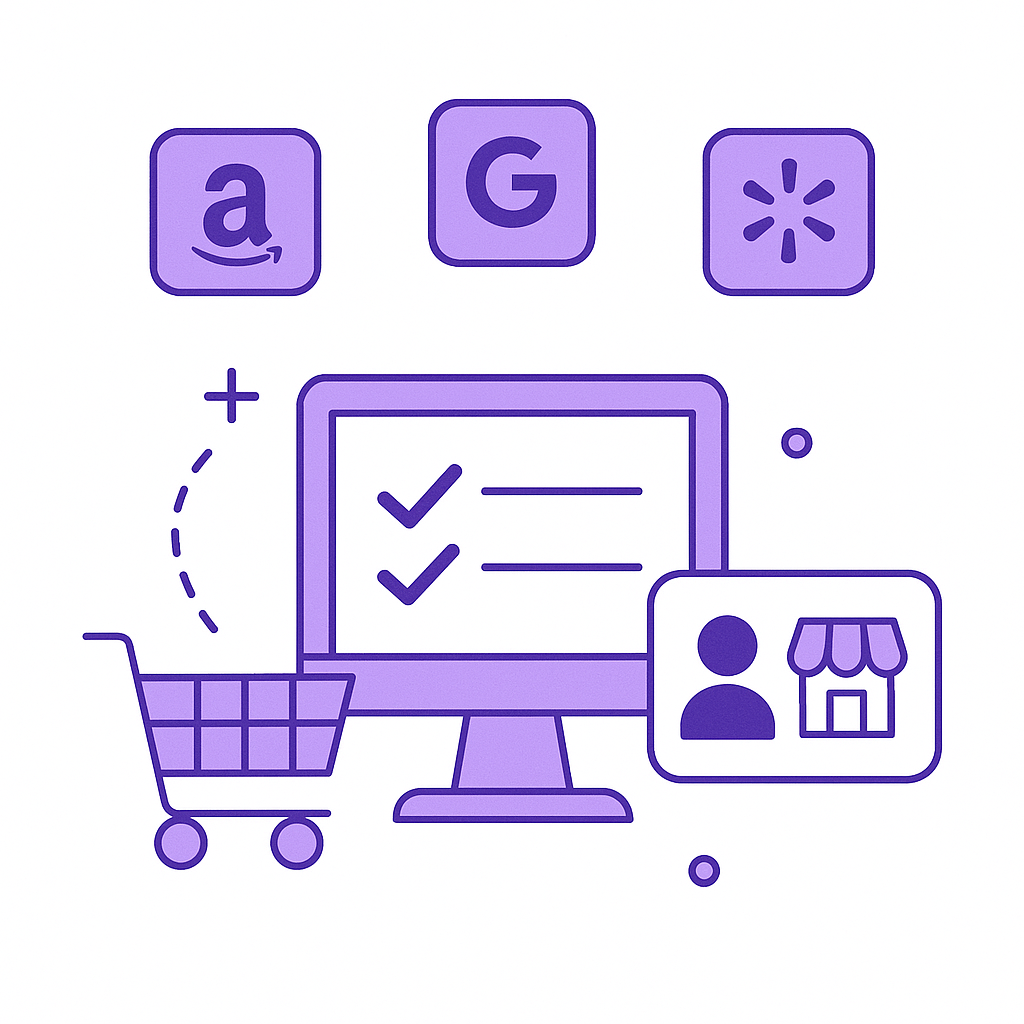Whether you’re launching a new ecommerce business or expanding your reach, selling on multiple marketplaces can open up new opportunities. But before you list your products, each platform has its own onboarding process—and some have unique requirements you’ll want to be prepared for.
Here’s a quick guide to creating seller accounts on five of the most popular platforms: Amazon, Walmart, Etsy, eBay, and Google Shopping.
How to Set Up an Amazon Seller Account
Amazon offers one of the largest global marketplaces for sellers, but it also has one of the most detailed registration processes. Before you start listing products, you’ll need to provide information that helps Amazon verify your identity, business, and product catalog.
You’ll need to submit:
-
Business information (name, address, registration number)
-
Personal identification (name, date of birth, government-issued ID)
-
Billing information (credit card or bank account details)
-
Store and product details (such as product codes, brand status, or certification
-
Verification (via an uploaded ID and potentially a video call with an Amazon associate)
If you’re not incorporated, you can register as an individual. Just select “None, I am an individual” when asked about business type.
What You Need to Join Walmart Marketplace
Walmart’s marketplace is geared toward established sellers and requires more formal documentation than some other platforms. If you have an operational business and a catalog that fits Walmart’s standards, getting approved can be a great opportunity to scale.
Requirements include:
-
Business Tax ID or license number (SSNs are not accepted)
-
Documents verifying your US business name and address
-
A proven history of ecommerce or marketplace success
-
A catalog that follows Walmart’s Prohibited Products Policy
-
Fulfillment capabilities (either through Walmart Fulfillment Services or a US-based B2C warehouse that handles returns)
Walmart’s approval process can take some time, so having your documentation in order before you apply is key. After you’ve been approved, you will need to do some payment sent. Walmart uses Payoneer and Hyperwallet.
Opening Your Etsy Shop
Etsy is designed for individual creators, makers, and small business owners looking to sell handmade goods, vintage items, or craft supplies. The process to open a shop is relatively simple and flexible compared to other platforms.
To open your Etsy shop, start by creating or signing in to your Etsy account. Your shop setup must begin on a desktop web browser, but once your shop is live, you can manage it from the Etsy Seller app. While Etsy doesn’t require a business license to open a shop, sellers are still responsible for complying with any applicable local or national business regulations.
You’ll need to:
-
Set your shop’s language, currency, and country
-
Add a profile picture and bio to personalize your seller account
Registering as an eBay Seller
eBay allows both individuals and businesses to sell on the platform, with separate requirements depending on the type of account you choose. It’s a flexible option whether you’re selling collectibles or managing a full-scale ecommerce operation.
To register, be prepared to provide:
-
Full legal name
-
Physical address (PO boxes are not accepted)
-
Date of birth
-
SSN (for individuals) or EIN (for businesses)
-
Business name and address (if registering as a business)
-
Government-issued ID (driver’s license or passport)
Once your account is verified, you’ll have access to eBay’s seller tools and can begin creating listings.
Getting Started with Google Merchant Center
Google Shopping works a bit differently than traditional marketplaces. Instead of selling directly through Google, you list your products using Google Merchant Center, which connects shoppers to your own website or checkout partner.
To get started:
-
Create a Google Merchant Center account
-
Sign in using your Google account
-
Indicate whether you sell online, in-store, or both
-
Choose your preferred checkout method
-
-
Add and verify your product data
-
Import your product feed manually or sync it from your ecommerce platform (like Shopify or WooCommerce)
-
Google Shopping helps increase visibility across Google Search, YouTube, and other services—but transactions typically happen on your own site.
Getting Started Across Marketplaces
Each marketplace has its own approach to onboarding, based on its selling model, buyer expectations, and policies. While Etsy makes it easy for individuals to open a shop, Walmart focuses on verified businesses with proven track records. Amazon and eBay offer options for both individuals and businesses, while Google Shopping requires integration with your website.
Before applying, make sure you understand what’s required and gather the necessary documents. Taking the time to set things up properly can help you avoid delays—and start selling faster.
Looking for a way to simplify multichannel selling? Sellbrite makes it easy to manage your product listings, inventory, and orders from one central platform.

